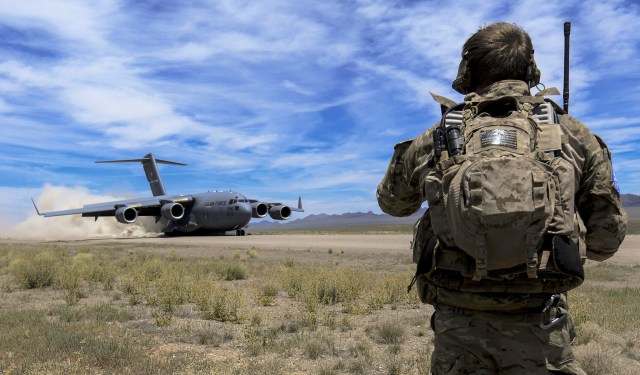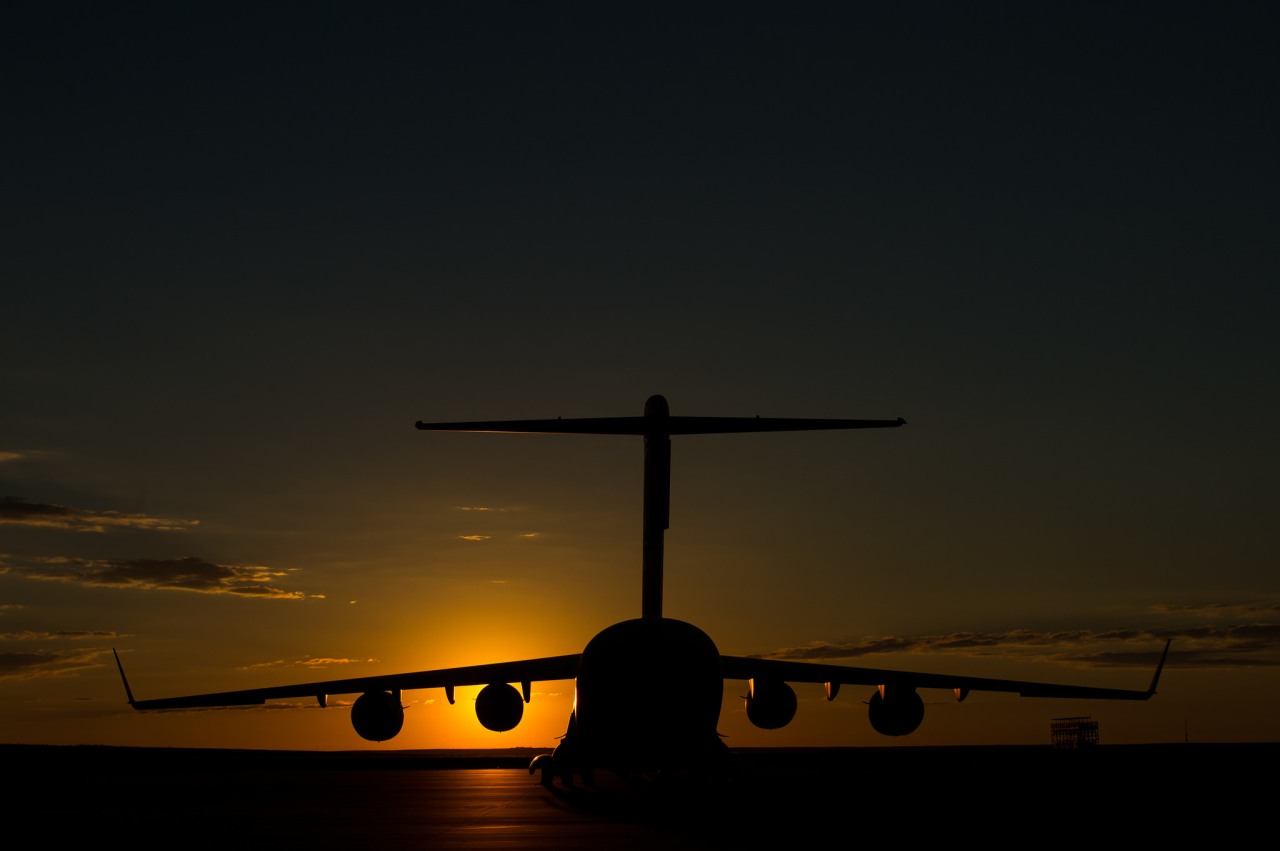By Jobie Turner.
The true asymmetric advantage the US military possess is the capability and capacity of its logistics. The supply and transportation means at the disposal of the joint force have great breadth and depth. US Transportation Command, in the assigned role as the mobility provider for war, has 1,203 aircraft and 379 ships at its disposal, between organic and commercial assets.[1] On the supply side, the Defense Logistics Agency is at the pointy end of a $34 Billion enterprise, undergirded by the largest economy in the world.[2] Outside of the United States, the military relies heavily on a vast network of allies and partners who provided bases and support to assist in the projection of US forces. Norms and standards of shipping by sea and air traffic, allow goods, services and by extension military assets, flow unimpeded over large parts of the globe. The translation of this logistic support into broader strategic interests is clear: since the end of the Second World War the United States and its allies have been able to move to war mostly unabated and undeterred.
Although the joint force possesses modern delivery methods (e.g. fast jet transportation) and vast command and control facilities, the system in total bears a striking resemblance to that established at the end of the Second World War. For the US military and their joint partners, moving to war and supplying battle tends to move in a standard ‘Hub and Spoke’ model like those laid out in the classic work “Logistics in the National Defense” by Henry Eccles.[3] In this model, the personnel and material move from the United States to larger bases and are then distributed to ever smaller locations as required by the mission. The ‘Hub and Spoke’ system allows for efficiency, reserve capacity, and the ability to predictively schedule sustainment. This system has done much to underpin US strategic goals—whether deterrence, influence, or other—and it will not last.
The System is at Risk
Joint Operational Environment 2016-2046 characterizes the future geopolitical realm by ‘contested norms’ and ‘persistent disorder’, a situation which includes direct challenges to the global commons.[4] Individual service studies and those of partner allies back up the same thesis.[5] What does this mean for logistics? Future long-range weapons, geopolitical ambitions, and the willingness for nation-states to challenge the rules-based order of the global commons may halt the ability of the joint force to move to war and supply itself. In short, the entire system that underpins US power projection is at risk.
Given the implications from the assessment of the future environment, there are many concepts that seek to address these concerns. For example, the US Army’s Multi-Domain Battle White Paper states, ‘adversaries will also exploit perceived U.S. weaknesses such as time and distance for force deployment and vulnerable logistics nodes and command and control networks.’[6] In addition, the Air Force Future Operating Concept states, ‘[t]eams can aggregate to produce mass when required or be distinct, disparate assets, depending on the required domain control effects.’[7] As these two examples imply, future warfare requires disaggregation of combat power to avoid detection and destruction, and then concentration when needed to produce operational effect. This operational construct will ripple down into the transportation requirements for war. The approach where large bases are seen as hubs with static smaller bases as spokes will be insufficient to the task. The future world of logistics will require speed, precision, and flexibility. There is an unwritten expectation that mobility will be underwritten by airpower.

USAF C17 during a recent joint forcible entry exercise; photo by USAF
Challenges and Opportunities by Air
Aircraft can move at great speed, airdrop with exquisite precision to need, and change destination locations mid-flight. While this agility outpaces movement by land and sea, it is also lacking in capacity. For example, a C-17 can be loaded, fly from CONUS to a point half-way across the globe in under 3 days, while a cargo ship can take up to 40 days to make the same journey. However, while it takes 1 to 2 large cargo ships to deliver the equipment for a single US Army Brigade that same equipment would require 330 C-17 missions to complete the movement. In sum, the entire fleet of C-17s in the inventory of US and its coalition allies could deliver the contents of one cargo ship.[8] This makes aircraft uniquely suited to carry things that are light in weight, smaller in size, and valuable—like personnel for example—while ships and ground transportation carry the rest.[9] In fact, over 90% of military cargo delivered from the CONUS goes by sea.[10] Airlift and ground transportation both rely on the cargo provided from the sea to large ports as the supply mechanism for delivery forward to smaller bases.
If future warfare demands more distributed operations, with more bases and more movement across the battlefield, airlift will be central to overcoming sustainment problems. There will be an expectation that airlift will substitute when ground lines of communication are cut, and other distribution capabilities are unable to keep up with the pace of operations. We should not forget its own limitations, however. Despite the size of the USAF, delivery by the air will not be able to handle the logistics requirements of even just one US Army brigade for more than a few days.[11] Furthermore, operations along contested lines of communication will themselves require offensive air operations and the use of vast amounts of fuel, munitions, parts, and supplies as well. Airlift can do much in the short term, but in no way can it, sustain a major operational campaign alone.
Airlift has always offered militaries adaptability and flexibility, and has been critical to the maintaining of operational tempo. At this juncture, however, it is important that ambition doesn’t outweigh reality. An expectation of unfettered airlift support may become a core weakness of emerging operational and tactical concepts. The enabling of national advantages in logistics capacity will therefore require new ways of thinking about airlift.
Jobie Turner is an officer in the United States Air Force with operational experience in C-130 cargo aircraft. The views expressed are the author’s and do not reflect the official position of the U.S. Air Force, Department of Defense, or the U.S. Government. He can be followed on Twitter @vicuslargo
[1] USTRANSCOM, “About USTRANSCOM,” https://www.ustranscom.mil/cmd/aboutustc.cfm). These are steady-state numbers and do not reflect the surge aircraft available under Civil Reserve Airlift Fleet activation.
[2] Defense Logistics Agency, “DLA At a Glance” http://www.dla.mil/AtaGlance.aspx (accessed 01 Oct 17)
[3] Henry Eccles, Logistics in the National Defense (Annapolis, MD: Naval Institue Press, 1997), 62 and 236. These pages give a good visual of how logistics flows from strategic to tactical, flowing from larger bases and organizations to small units.
[4] The Joint Staff, “Joint Operating Environment 2035: The Joint Staff in a Contested and Disorderd World,” (Washington, DC: Department of Defense, 2016), ii.
[5] See United States Air Force, “Air Force Strategic Environment Assesment 2016-2036,” (Washington, DC: HQ United States Air Force, 2016); United States Marine Corps, “Futures: 2030-2045,” (Washington DC: USMC, 2016).
[6] United States Army, “Multi-Domain Battle: Combined Arms for the 21st Century,” http://www.tradoc.army.mil/multidomainbattle/docs/MDB_WhitePaper.pdf (accessed 01 Oct 2017).
[7] United States Air Force, “Air Force Future Operating Concept,” (Washington, DC: HQ Air Force, 2015), 18.
[8] Government Accounting Office, “Options for Strategic Military Transportation Systems,” (Washington, DC: Government Printing Office, 2005), 16-17.
[9] Smaller aircraft, such as C-130s and helicopters, follow the same trend. They are fast transportation assets with limited capacity.
[10] Darren Mcdew, “On the State of the Command” (paper presented at the Testimony Before the Senate Armed Services Committee, 2017), 8.
[11]Colin Clark, “Not enough C-17s, Tankers, or Ships for Hot War: TRANSCOM,” https://breakingdefense.com/2017/05/not-enough-c-17s-tankers-or-ships-for-hot-war-transcom. (accessed 01 Oct 17).. Gen McDew, the USTRANSCOM commander, recently stated that “We can do 200 C-17s…We do not have the capability I wish we had”

“Furthermore, operations along contested lines of communication will themselves require offensive air operations and the use of vast amounts of fuel, munitions, parts, and supplies as well.”
Yes… in most cases, it will be a cascading nightmare of challenges that are amplified by vast distances from solidly allied nations. Imagine the logistics nightmare any operations in the South China Sea could become.
LikeLike